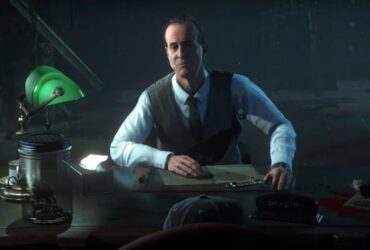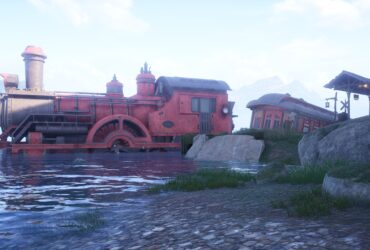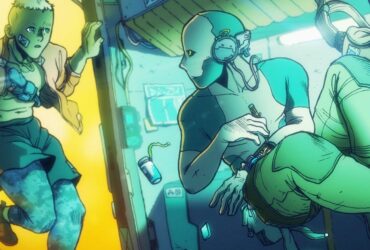Have you ever chewed fog? Of the many pleasures that games have given us, I’m not sure that I can recall it. Even in the clammier moments of Silent Hill 2, when the mists bulge and bruise with all manner of malevolence, I couldn’t tell you what it tastes like. The question arises because of a booklet, that of WipEout, for the PlayStation, which briskly summarises the joys within: “Pick the team you want to race for. take control of your souped-up anti-gravity racer. then ride the six huge circuits leaving the rest to chew the fog.” Note the lack of capital letters at the launch of each sentence. In this world, there is never such thing as a full stop.
The words belong to Damon Fairclough, who worked at Psygnosis, the legendary, now closed Liverpool-based development studio, in 1995. In a sense, his brief was simple: to write game manuals. Though, given that Fairclough was credited in the finished version of Wipeout 64 with providing “manual text and insanity,” we ought to assume that it soon warped from the simple into something else. When I asked him recently about his process, he described that time in cheery tones. “It was kind of like a joke,” he says. “There was always that sense of: not a lot of people read this, you could kind of go to town with it.” Fairclough was given details – ship sketches, track designs – and was tasked with giving them context. “You would get these crumbs from the developers,” he says. “You would just kind of spin a load of stuff around that.”

There was little sense, back then, that the spinning would lead a horde of devoted fans into dizzy reverence. “What I never really thought about was the impact this stuff had,” says Fairclough. “People who really got into the game then loved to read the story bit.” He’s right, but quite why this should be the case is tough to pin down. Fairclough is, among other things, a copywriter. (In a campaign of his for Toyota, advertising the company’s pledge for a full car service in sixty minutes, we see a man with a satchel clutched above his head in the rain, with the line “Just think what you’ll be missing” printed in the downpour.) Though Fairclough is unlikely to be asked to craft an undergirding mythology when he is, as he puts it, “writing about widgets for a bathroom catalogue,” his commercial instincts, along with his own obsessions, are essential to WipEout’s fiction.
Consider the following: “It’s about cut-throat competition. It’s about the technology, and the landscape, and the venues. It’s about the history too, because once there’s a history – once the mystical transformation from street plan into sound wave has occurred – it will have a tendency to occur again.” He is writing there not about WipEout, with its unbroken vectors of stone, steel, and light, but about Sheffield, where he grew up, and the music of a certain place in time. Show this passage to any lover of WipEout, though, and they will nod in recognition at the weird pull of its lore. Here is a sci-fi racer, fixed on little other than cheek-peeling velocity, with no story or characters to absorb; and yet it hangs around in your memory – not just the pure and hurtling hit of a first-place finish but the feel of being adrift, the burn of a certain place in time.
For Fairclough, the two are almost inextricable. I asked him about his ruminations on Sheffield – housed on a blog called “Noise Heat Power” – and he explained that they were about ageing and looking back. “That specific Sheffield that I grew up in, where this happened and this happened and these certainties that I took for granted existed, changed really a lot,” he says. “Industry, landscape, certainties about what the city would look like in the future, when I was young I would imagine that it was going to get more and more concrete and brutalist and, you know, that would just proliferate, and that’s the world we would live in. I was quite excited about that.”
So, how do you get to dreaming up the history of WipEout when you have spent years staring ahead, chewing the fog of an uncertain future? “I was never a big sci-fi buff, really,” says Fairclough, “so I don’t always know where all the details are coming from.” What are these details, exactly? We have the origins of the anti-gravity racing league, laid out, in that same booklet, as a collage of press clippings. An article in New Transport Monthly, dated 2nd February, 2038 (“Scientists who refused to bow to political pressure have emerged as key players in developing the transport system”); another in the “Biz News” section of Race Dayz, a US journal, from 8th June, 2044 (“Be assured – motor racing is DEAD”); and an introduction to the official programme of the F3600 Championships, from chief executive Dirk Breakwater (“To the world watching this event, already bigger than soccer’s World Cup or the Olympic Games”).


Then, there are the teams. Not just the glorious ships, which resemble the upturned, painted, and rocket-powered contents of a cutlery drawer, but the business that beams out at us from the margins. We get a string of corporate mottos that trim each team with just enough geography and posture. For Federal European Industrial Science and Research, better known as FEISAR: “The Muscles Behind Brussels.” For American team Auricom: “Pushing Back the Boundaries,” as if all this were just another frontier to tame. And for G-Tech, a Japanese team introduced in WipEout Fusion, we get the phlegmatic: “Products for an accelerated age.”
“I was packing it with in-jokes, private stuff that was funny to me…”
Notice, in that last line, that it isn’t the products that have caused the acceleration, merely catered for it; it’s the age itself that has quickened, stoked by a consuming hunger. Fairclough gives us glimpses of WipEout’s world, but they are glimpses from the inside: refracted through its media and sealed in the bright smog of its advertising. It’s almost a Pop Art sensibility. Think of Roy Lichtenstein, cutting strips of American life into lurid comic form, hinting at weight and darkness but locked in an anti-gravity style. It’s no wonder that The Designers Republic was drawn to WipEout, creating its box art and much of its in-game branding; that studio has always specialised in the process by which the ironic and the cynical is relit and steam-cleaned until it stirs.
The art of good game manuals is one of the saddest semi-casualties of the current era. I was touched when Rockstar Games cleaved to tradition, with the release of Red Dead Redemption 2, and included a fold-out map. It was a gesture, in keeping with the overriding theme of that game, toward an outmoded way of life. More than that, though, it acknowledged the will that games have to bolt their enclosures and spur the real world into living colour. Hence the in-game booklet of Tunic, which you filled in and decoded as you played. The pages took shape in step with your understanding of the game’s inscrutable country – a delicious nod to the role of the manual, whose purpose is to illuminate the strangeness onscreen. It feels almost inconceivable now that a writer could have such an impact on the texture of a game without actually being in it. If Fairclough’s work on WipEout – most of it carried out on the edges, in orbit of the event itself – has power, that is because it is, against the odds, personal.

“I was packing it with in-jokes, private stuff that was funny to me,” he says, speaking about his work on the website for WipEout Fusion. Along with writing manuals for the series, Fairclough also wrote online pieces and an entire fictional press pack, which he imagined being handed out to journalists at one of the anti-gravity racing events. “In terms of me looking back at the whole series, Fusion is by far the most amazing,” he says, “because that was the one where I was just allowed to really go to town, nobody ever saw that press pack stuff, I had just done more work than was required, just for my own self-interest really.” Indeed, if there is a defining spirit to Fairclough’s work on WipEout, it wouldn’t be self-interest but constraint – the freedom to express oneself within the limits of a brief.
“I knew I wanted to write,” he says, “but knowing what to write about, for me, at that point in my life, was quite a sticking point.” For Fairclough, being at Psygnosis at that time was a way to come unstuck, as it were. He was given a chance to cast out the old adage of writing what you know, and to write about what he didn’t know – gradually, of course, his experience would leak in. “A job where you were getting briefs like this was suddenly really liberating,” he says, “because it meant I could do this kind of work that I felt I should be doing, and a subject was given to me, and a kind of vague framework, and I really feel that in many ways that helped me just in my writing generally.”
Much of Fairclough’s work on WipEout is, in some ways, no longer around. The booklets were produced in limited quantities, and his work on WipEout Fusion has pretty much vanished. “Unfortunately, it was all done in Flash,” he says. “It’s gone.” What remains, though, is there not only on a hundred WipEout Wiki pages but, more importantly, whenever you fire up one of the old games. You can catch it in the surreal blend of the corporate and the darkly comic, and if you zip through a circuit or two and sense that these odd, far-flung vistas not only signal a palpable future, but that they have an unreachable past, then Fairclough has done his job. He was a young writer, locked to a ready-laid track, who drifted lightly above his brief and dreamt up something real. Whether his work is bound in old booklets or gone in a flash, it leaves an unmistakable trace. And if, like me, you regularly long for more WipEout, take heart. Once there’s a history, it will have a tendency to occur again.
function appendFacebookPixels() { if (window.facebookPixelsDone) return; !function(f,b,e,v,n,t,s) {if(f.fbq)return;n=f.fbq=function(){n.callMethod? n.callMethod.apply(n,arguments):n.queue.push(arguments)}; if(!f._fbq)f._fbq=n;n.push=n;n.loaded=!0;n.version='2.0'; n.queue=[];t=b.createElement(e);t.async=!0; t.src=v;s=b.getElementsByTagName(e)[0]; s.parentNode.insertBefore(t,s)}(window, document,'script', 'https://connect.facebook.net/en_US/fbevents.js');
fbq('init', '560747571485047');
fbq('track', 'PageView'); window.facebookPixelsDone = true;
window.dispatchEvent(new Event('BrockmanFacebookPixelsEnabled')); }
window.addEventListener('BrockmanTargetingCookiesAllowed', appendFacebookPixels);
Source link












Leave a Reply